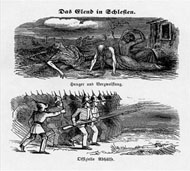„Die Erfindung des mechanischen Webstuhls, billige Textilimporte aus England und ein Überangebot an Arbeitskräften drückten die Preise für Textilien. Die Weber in Schlesien konnten mit ihren in Handarbeit hergestellten Produkten nicht konkurrieren und gerieten zunehmend ins Elend. 1844 kam es zu einer „Hungerrevolte“ von mehr als 3000 Lohnwebern, die sich rasch ausbreitete. Preußische Truppen schlugen den Aufstand blutig nieder. Der Weberaufstand war für viele zeitgenössische Schriftsteller Anlass zur Kritik an den sozialen Verhältnissen.“
2. A text and a caricature: “Weaver’s Riot and Redres“
Questions
Geographical/Historical Context
The importance of the riot of 1844 consisted in the public attention it attracted. Contemporary publications and literature aptly present and discuss the topic.
Two thirds of the Silesian population were still subjected to landlords and had to pay feudal dues. The Silesian weavers tried to make up for the drop in the price of their goods by quantity. Thus, the quality of products deteriorated further. Technical innovations and modern looms, like the ones already existing abroad, did not offer any help or relief, since home workers could not afford them.
On June 3, the weavers from Peterswaldau met and marched in front of the house of the factory owner, Zwanziger. The factory owners, Ernst Friedrich and August Zwanziger, ordered their servants, equipped with stones and cudgels, to disperse the small group of protesters. Moreover, they ordered the local police to arrest a weaver, Wilhelm Mädler.
Demanding the release of Wilhelm Mädler and a pay rise, a protest march was organized on June 4, 1844, which was joined by nearly all home workers from the vicinity. When they arrived in front of Zwanziger’s house, the factory owner was not there. Subsequently, the crowd burst into Zwanziger’s house and destroyed all the furnishings. Likewise, they vandalised the administrative building, the warehouse and the factory. The Zwanziger family fled to Breslau.
Meanwhile, the authorities prompted the intervention of the Prussian military and the situation got out of control. Eleven people were shot, further 24 severely injured. This line of action fuelled the rage and led to several lootings. The military unit firstly yielded to the crowd armed with cudgels and stones, yet after the arrival of the back-up the riot was quelled on June 6, 1844. Numerous weavers were arrested and sentenced to gaol, detained in the fortress or flogged.
Answers to the questions
1. Which persons, events or conflicts does the caricature refer to?
It refers to the needs of the Silesian weavers, their riot and its military suppression by the Prussian military.
2. What design elements were used in the caricature?
No colours, the scenery is dark, people do not have faces, which expresses death and aggressiveness. Crosses line the street in Silesia.
3. What is the general message of text?
The state did not undertake any attempts to help the workers. The violent suppression of the rebellion and the fate of the Silesian weavers, however, drew nation-wide attention.





Presentation